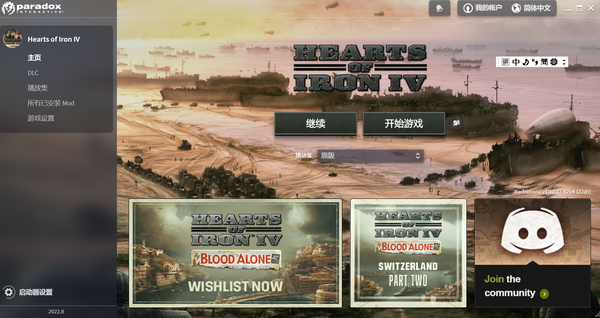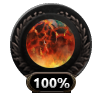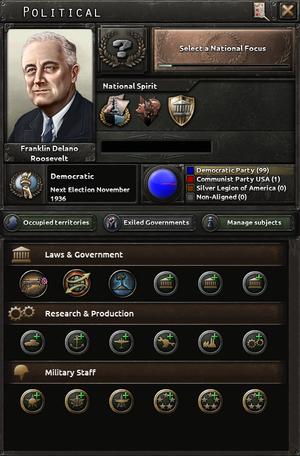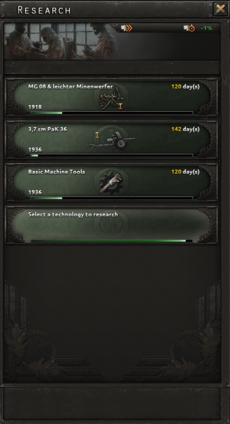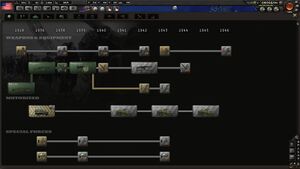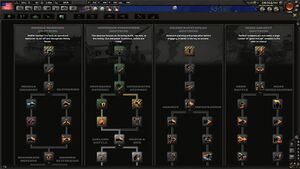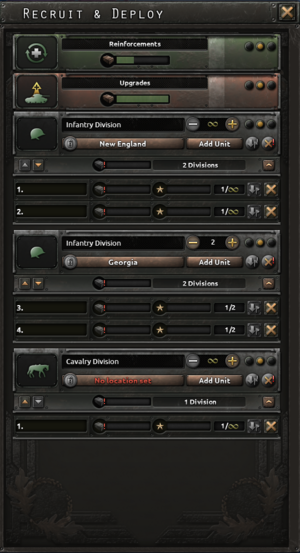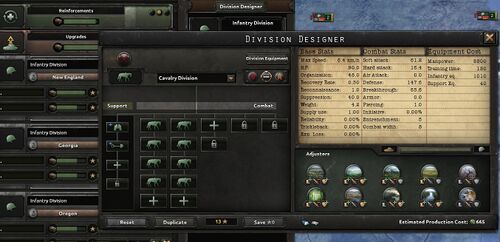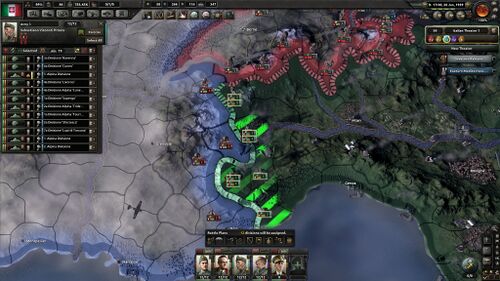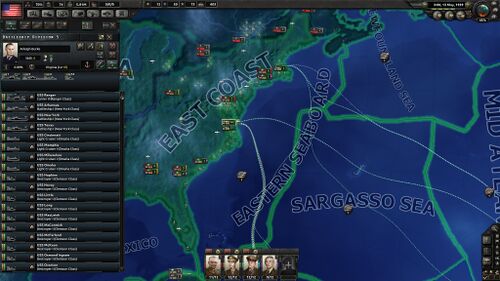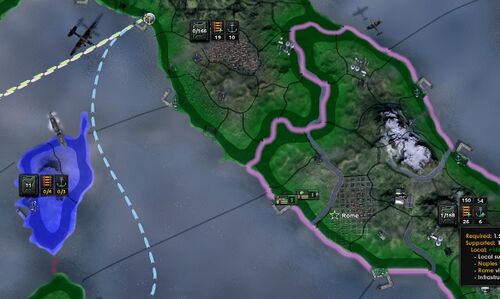本指南的目的是为初玩者浏览《钢铁雄心4》的界面和机制准备。有关用户界面和机制的更多详细信息,包括某些计算背后的详细数学信息,请访问专门针对这些概念的文章进行阅读。
开始游戏之前
在点击“开始游戏”按钮之前,先熟悉显示的信息,各种按钮和选项的名称以及这些按钮和选项的功能可能是一个好主意。
- 游戏版本:观察显示游戏版本为1.9.3和校验码(四位数)的图形。将已保存的游戏设置为当前正在玩的游戏版本和校验码。如果保存的游戏版本和校验码与游戏版本和校验码不匹配,则保存的游戏将无法工作。请注意,游戏通常是自动更新的,在
 炮手就位 (1.9版本)发布后,1.8版本将不会工作,除非游戏回滚到匹配的版本。这个回滚过程可以在Paradox论坛上找到。请注意,这个过程需要为每个拥有的游戏分支提供一个游戏代码,并且需要一个Paradox交互式帐户来查看这些代码以输入到Steam。
炮手就位 (1.9版本)发布后,1.8版本将不会工作,除非游戏回滚到匹配的版本。这个回滚过程可以在Paradox论坛上找到。请注意,这个过程需要为每个拥有的游戏分支提供一个游戏代码,并且需要一个Paradox交互式帐户来查看这些代码以输入到Steam。 - 设置:点击上方“设置”按钮可以打开设置菜单。此菜单有2大条目:游戏设置和启动器设置。游戏设置菜单可分为:图形、系统、游戏三类。
- 图形:显示模式有三种选择:全屏、窗口和无边框全屏。建议您选择无边框全屏,因为在一些系统上,窗口和无边界模式已经被告知会导致启动问题,如黑屏和启动失败(参考对游戏进行故障排除)。全屏分辨率允许多种选择,如1600x1024、1680x1050等。将游戏的分辨率与显示器的本机分辨率相匹配,通常将会获得最佳的观看和游玩体验。
- 系统:在此您可以选择您需要的语言种类,如果您想体验中文游戏,请选择English。
- 清除用户目录按钮:单击此按钮将清除您《钢铁雄心4》的用户目录。只有当你遇到游戏崩溃时才点击这个按钮。
- 启动器设置:在此您可以选择是否开启“选择退出个性化内容”。
- 创建帐户按钮:点击此按钮创建一个Paradox Interactive帐户。建议您创建一个帐号,这样您就可以在游戏出现问题时获得技术支持。若想登录Paradox Interactive网站,还需要一个Paradox Interactive账户来访问每个游戏之前拥有的分支代码。这是由于《一般资料保护规例》的颁布。其他好处还包括访问错误报告,游戏建议,等等。
- DLC选项栏:点击DLC选项栏“管理DLC”将显示为这个游戏购买的所有可下载内容。每一个DLC旁边将放置一个按钮,如果显示 绿色 表明它已经被启用,相反,没有显示绿色则表示该DLC没有被启用。
- Mod选项栏:点击Mod选项栏“管理mod”将显示一个详细列表,里面包含您所拥有的mod。每一个mod旁边将放置一个按钮,如果显示 绿色 表明它已经被启用,相反,没有显示绿色则表示该mod没有被启用。mod可以从Steam内的创意工坊下载。需要注意的是,有些mod会在游戏过程中关闭获取成就的功能,而有些mod没有为最新版本的游戏进行更新,这可能会导致系统崩溃。阅读作者关于他们的mod的描述通常会写明这个mod是否与成就兼容,以及他们的mod更新到了什么版本。
排除游戏故障
如果游戏无法启动、死机、崩溃到桌面(CTD)或“黑屏”,请尝试下面列出的解决方案。首先列出最常见的原因和解决方案。联系技术支持或访问论坛获得额外帮助。您需要一个Paradox Interactive帐户来取得技术支持。
- 一些杀毒程序会自动阻止可执行文件:尝试添加dowser.exe和steam.exe到防病毒例外列表。
- 过时的显卡驱动程序:尝试下载和安装最新的显卡驱动程序。
- 不兼容的操作系统设置:尝试Windows兼容性设置通过导航到dowser.exe文件(默认的文件路径C:\Program Files (x86)\Steam\SteamApps\common\Hearts of Iron IV),右键单击dowser.exe文件,点击属性,点击“兼容性”选项,并尝试不同的设置。
- 不兼容的显卡设置:尝试全屏运行游戏而不是窗口模式。在游戏启动界面,点击“设置”,打开图形目录。此目录有4个项目:显示模式、显示器、垂直同步和全屏分辨率。显示模式有三种选择:全屏、窗口和无边框全屏,选择全屏选项。
- 不兼容的显卡设置:尝试手动编辑launcher-settings.json文件,首先导航到launcher-settings.json文件(默认文件路径C:\Users\Documents\Paradox Interactive\Hearts of Iron IV\launcher-settings.json)。然后打开launcher-settings.json文件,手动更改文本如下:fullScreen = yes和borderless = no。注意:只更改全屏和无边框文本设置。不要更改或删除其他设置,除非您备份了您的文件,并知道您正在做什么。
- 用户文件损坏:尝试清除用户目录。在设置-游戏目录中,点击“清除用户目录”按钮。然后退出游戏并重新启动它。
- 游戏文件损坏:尝试重新安装游戏。
- 将重要的游戏存档移到备份文件夹中。
- 到Steam,从Steam库中选择Hearts of Iron IV,然后右键选择卸载。
- 导航到C:\Program Files (x86)\Steam\SteamApps\common并手动删除Hearts of Iron IV文件夹。
- 导航到C:\User\(用户名)\Documents\Paradox Interactive并手动删除Hearts of Iron IV文件夹。
- 打开Steam,从Steam库中选择Hearts of Iron IV,然后点击安装,在此期间不要启动游戏!待在steam界面!
- 在Steam上右键点击Hearts of Iron IV游戏,选择属性,点击本地文件选项,然后点击验证游戏文件完整性按钮。这将验证刚刚安装的游戏文件。会看到一条“所有文件都成功验证”的消息。
- 启动游戏时不要开mod。
- 测试游戏。
开始游戏
单人游戏 提供《钢铁雄心4》的单人游戏。所有其他国家将由电脑控制。单人菜单允许玩教程或开始一个新的游戏,以及加载以前保存的游戏。
玩教程可让您快速了解游戏过程,因此强烈建议您使用。完成教程游戏后,它就好像是标准游戏一样,可以继续进行游戏。
多人游戏 允许《钢铁雄心4》的玩家与其他人在线一起玩。最多32名玩家可以在同一时间玩《钢铁雄心4》(当然也包括竞争和合作的多人的游戏)。游戏的主机能够开始一个新的游戏或加载之前的存档。
选项 允许自定义《钢铁雄心4》的声音,外观和游戏细节。这包括显示器分辨率的调整和用户对图形和声音的偏好。第一个选项包含了非常重要的“游戏设置”。
一旦通过基本设置,玩家便可以选择一个剧本和一个国家在游戏时段内进行游戏。
1936年的世界
1936年的剧本从1936年1月1日开始。1936年的情景是最有可能导致第二次世界大战的替代版本的情景,因为它始于更少的联盟或战争。要想在战争开始前完成经济的组织和计划,就必须从1936年开始。这是为军队和战争计划奠定的基础,以生产、科研和外交为重点的剧本。
选择一个国家
每个剧本会显示一个主页面,主页面上有七个主要国家( ![]() 法国,
法国, ![]() 美利坚合众国,
美利坚合众国, ![]() 联合王国,
联合王国, ![]() 德意志国,
德意志国, ![]() 意大利,
意大利, ![]() 日本和
日本和 ![]() 苏维埃联盟) 以及任何在启用DLC后出现的推荐国家。无论选择哪一个国家,都会显示一幅世界地图,以允许多种选择。玩家可以选择他们想要游玩的任何国家,但应该意识到像
苏维埃联盟) 以及任何在启用DLC后出现的推荐国家。无论选择哪一个国家,都会显示一幅世界地图,以允许多种选择。玩家可以选择他们想要游玩的任何国家,但应该意识到像 ![]() 不丹这样的国家可能不是最适合作为新人第一次游玩的国家。我们推荐任何您认为您最了解的国家,或者最有趣的国家!
不丹这样的国家可能不是最适合作为新人第一次游玩的国家。我们推荐任何您认为您最了解的国家,或者最有趣的国家!
游戏设置
在正式开始游戏前,你可以在地图的右下角选择进行游戏设置。 你可以通过它去调整 ironman 和 historical focus ,同时你也可以通过难度进行游戏难度的选择。当然,你也可以选择是否加强一个或多个主要国家/地区(这会让那些国家/地区更加强大)。那里有一个按钮,用于选择是否在游戏中获得steam achievements ,但这需要你选择在铁人模式下,并且选择普通或以上难度。最后,按下右下角的“开始游戏”的按钮,进入游戏,开始一场属于你的二战吧!
难度设置
- 主条目:难度
玩家可以选择不同的难度,不同难度下将全局性地对自己/AI进行加强/削弱。 此外,玩家还可以对七个主要国家/地区进行调整,从而仅对一个实体及其所玩的战线进行加强/削弱。
界面
- 主条目:用户界面
对于熟悉Paradox游戏的老玩家,《钢铁雄心4》的游戏界面并不难以上手,屏幕左侧被用来处理大型国家事务,警示标签会显示在屏幕上方用以提示某项事务需要注意,屏幕右侧则是各个部队的信息,在屏幕最上方的信息框中则包括了当局游戏的世界信息和国家信息。
顶部信息框
以下信息框从左到右排列为:
 政治点数
政治点数- 只是一个表示国家的领导层所积累的政治力量的数值,政治点数可以用来完成国策,指派大臣(政治顾问、设计师、理论家和武器设计公司),改变贸易和法案,以及进行某些外交行动。每个国家会获得每日 +2 政治点数,这一数值可被领袖特质,政治顾问,稳定度,民族精神,国策 选择,政治事件,政治决议,或玩家的行为修正。
 稳定度
稳定度- 衡量人民对政府的支持,低稳定度的国家将会遭受工厂与海军船坞,政治点数获取和消费品的产出惩罚修正。平均稳定度为 50% 。当稳定度位于 50% 时既不受惩罚,也没有任何增益。稳定度高于 50% 时会得到数值相同的工厂与海军船坞,政治点数获取和消费品的产出增益修正。
 战争支持度
战争支持度- 衡量人民支持战争的数值,战争支持度直接影响动员速度、指挥点数获取和核心领土攻防能力。法西斯国家与某些激进的国家拥有较高的初始战争支持度,但最终会被在防御战争中的民主国家超过。国家在防御战争中会获得增加战争支持度的增益而在进攻战中会承受降低战争支持度的减益。战争支持度同样也受全球紧张度、敌军轰炸和盟友的干预等因素影响。低战争支持度国家更倾向于投降。
 指挥点数
指挥点数- 指挥点数表示了政府绕过指挥系统,直接影响军队的能力。指挥点数可以用于实行几种军事行动和提拔将军,其上限为 100 点,其上限与增长速度可以被学说和民族精神影响。指挥点数不能用于晋升元帅,除非激活
 唤醒勇虎 。
唤醒勇虎 。
 陆军经验 ,
陆军经验 ,  海军经验 和
海军经验 和  空军经验
空军经验- 随着单位的战斗,或者在演习的情况下,他们将获得经验。陆军经验可以在单位设计器中用于编辑或发明陆军师模板,或修改坦克和坦克变型装备。空军经验可以花费在对飞机的修改上,使其获得速度、火力等方面的加成。海军经验可以花费在舰艇的改装上。或者在启用了
 炮手就位 DLC后,可以用在设计新型船只或升级旧船只。
炮手就位 DLC后,可以用在设计新型船只或升级旧船只。 - 这三种经验都可以用来获得研究速度的加成, 100XP 可以分别为陆、空、海军学说的研究速度加成 100% 。海军XP可以用来获得某些海军模块 50-150% 的研究速度加成。
 核弹
核弹- 当核武器被研发完成后,一个
 图标将会出现在顶部信息栏,显示该国拥有多少核弹。
图标将会出现在顶部信息栏,显示该国拥有多少核弹。
主要地图模式
地图模式 - 包含以下三个模式,是游戏中常用的模式。也叫做 默认地图模式。
国家 代表国家的陆地边界。 与国家的互动在外交范围内发生。 每个国家都有名字。
国家建立在地区之上。 工厂,基础设施以及使用“民用工厂”建造的大多数其他建筑都是在地区完成的。 每个建筑在可以建造多少次也有限制。 每个地区也有名称。
每个地区都有省份。 与各省的互动主要是通过陆军和一些建筑完成的,即要塞和海军基地。 省份没有名称,除非它们有一定数量的胜利点,并且其详细信息在地区概述屏幕的底部可见。
玩家使用其他三种地图模式,其 地区 或区域的定义在很大程度上忽略了国界,并可能涵盖多个州。
海军地图模式 - 向海军舰队下达命令时,最多可以选择三个相邻海域。 完全独立于地形图模式。 海域都有名字。
空军地图 - 覆盖海军和陆军地图模式。 以空军基地作为基础,在给定的战略区域分配任务。 然后,空军基地将使其飞机在战略区域内执行任务。 战略区域也有名称。
补给模式 - 覆盖陆地地图,并分为补给区域。 为了游戏目的,虽然固定了各个区域的统计信息,但给定区域的范围却由构成该区域的占领省份来确定。 他们没有名字
所有这三个区域均使用蓝色/绿色/黄色/红色边框突出显示,以指示该区域相对于优势(陆地/海洋)或供应(充足)的中/良好/中/不良等状况。
全球紧张度
屏幕的右上方是 ![]() 图标,下侧标有百分比,用于表示全球紧张度数值。这个百分比是衡量世界离世界大战有多近的标准。一些外交和军事行动,特别是民主国家或中立国家的外交和军事行动,需要世界紧张局势达到特定数值。历史事件、宣战和其他敌对外交行动都会增加全球紧张度。点击地球仪,玩家可以进入影响全球紧张度的事件列表和正在进行的战争列表。
图标,下侧标有百分比,用于表示全球紧张度数值。这个百分比是衡量世界离世界大战有多近的标准。一些外交和军事行动,特别是民主国家或中立国家的外交和军事行动,需要世界紧张局势达到特定数值。历史事件、宣战和其他敌对外交行动都会增加全球紧张度。点击地球仪,玩家可以进入影响全球紧张度的事件列表和正在进行的战争列表。
主菜单栏
国家信息与发展
屏幕的最左边是国旗。点击这面国旗可以查看国家状态,其中包括国家领导人的肖像、政治制度和四种不同意识形态的支持度、现在启用的民族精神和三排可以通过花费政治点数进行变更的按钮,其中包括管理占领区,流亡政府和傀儡国按钮。
当没有国策被选用时,会有一个警示标签出现,大多数国策需要 70 天激活,并且每一天消耗 1 政治点数。国策就像科技树一样呈树状排列,但并非解锁科技,而是关于国家的方向选择。可以选择,暂时专注于工业或技术的增长,或者将国家的外交方向定位在某些其他国家,形成研究条约,启动派系,获得主张,或威胁战争。有些国策选择是相互排斥的,比如说德意志国不可能同时对中国和日本友好。
这个菜单还允许花费政治点数来改变政府法律或雇佣政治、军事和工业顾问,这些都在内阁一栏。大多数的改变将花费至少 150 政治点数,而非常强大的顾问可能会花费高达 250 政治点数,极其强大的法律和顾问将花费高达 300 政治点数,有时甚至比这更多。
法律 & 政府
- 征兵法案:影响有多少可用人力可以服兵役、工厂产出、船坞产出、建筑建造速度和训练时间。
- 贸易法案:影响有多少资源用于出口、工厂产出、船坞产出、建造建筑速度和研究速度。
- 经济法案:影响消费品专用工厂的数量、人力供应、民用和军用工厂的建设速度、工厂的转换速度。
最多可以雇佣三位政治顾问以提供不同领域的加成。
科研 & 生产
可以添加许多设计公司,比如坦克制造商、舰艇制造商和飞行器设计和产业公司,并能带来对应的生产减免和效果增益。这些增益包括减少研究时间增加装备产出和增强装备作战能力。
同样也可以雇佣理论家减少学说研究时间并获得三军经验,某些理论家甚至可以带来战斗增益。
军事参谋
军事参谋可以提供陆、海、空三种部长职位,共有最多三人候选。
决议
游戏界面顶部带有木槌的灰色按钮(![]() )可以打开打开“决议”菜单。决议允许一个国家完成一些特殊的项目,例如改变意识形态,引发边境冲突,取缔政党,规制新闻审查,资源勘查等。这些决议通常花费 25 至200 的政治点数,除了一些根本不需要政治点数的决议。决议临界于国策树和事件之间(允许进行额外的修改和机制调整)。
)可以打开打开“决议”菜单。决议允许一个国家完成一些特殊的项目,例如改变意识形态,引发边境冲突,取缔政党,规制新闻审查,资源勘查等。这些决议通常花费 25 至200 的政治点数,除了一些根本不需要政治点数的决议。决议临界于国策树和事件之间(允许进行额外的修改和机制调整)。
科研
- 主条目:科研
游戏界面顶部带有烧瓶的灰色按钮(![]() )可以打开科研菜单。一般情况下,一个国家有3或4个科研槽可用于研究特定科技,但是通过完成特定国策,国家可以获得额外的科研槽,通常最多为5个。
)可以打开科研菜单。一般情况下,一个国家有3或4个科研槽可用于研究特定科技,但是通过完成特定国策,国家可以获得额外的科研槽,通常最多为5个。
游戏中共有十一类科研项目。每个国家都根据情况从历史上所拥有的适当的科技和学说入手。所有科研树(学说除外)均沿历史时间轴标记。提前研发科技或单位所花费的时间要比在历史时间轴所标记时间年份或之后进行科研的时间长。通过完成某些国策可以减少这种惩罚。
步兵:研发更好的步兵武器和不同类型的步兵师。在这里可以解锁机动步兵,伞兵,海军陆战队,山地步兵等。
辅助部队:研发可以隶属于师的支援连。其中包括工兵连,宪兵队,侦察连,维修连,后勤连,通信连,野战医院。
装甲车辆:研发轻型,中型,重型和两栖坦克,以及基于未锁定的变型坦克。
火炮:研发防空炮,火炮,反坦克炮和火箭炮。
陆军学说:大多数主要国家将从最初的陆军学说开始。这可以改变,但是所有陆军学说的选择都是互斥的。选择的每种陆军学说都会分配自己的战斗加成。
海军:研发更先进的军舰,潜艇,运输舰等,以及 ![]() 炮手就位 DLC中用于升级军舰,制造衍生型的模块。
炮手就位 DLC中用于升级军舰,制造衍生型的模块。
海军学说:大多数主要国家将从最初的海军学说开始。这可以改变,但是所有海军学说的选择都是互斥的。选择的每种海军学说都会分配自己的战斗加成。
空军:研发不同类型的战斗机,支援机,轰炸机,侦察机和舰载机以及它们的衍生型。
空军学说:大多数主要国家将从最初的空军学说开始。这可以改变,但是所有空军学说的选择都是互斥的。选择的每种空军学说都会分配自己的战斗加成。
工程学:可科研雷达科技计算机科技的工程,以及研究核和火箭科技。
工业:科研工业科技树以提高玩家所选国家的生产效率,生产能力和战略资源获取能力。
外交
- 主条目:外交
游戏界面顶部带有握手的灰色按钮(![]() )可打开外交菜单。这是国家列表和一些国家过滤器的按钮,用于缩小您所需要的列表范围。
)可打开外交菜单。这是国家列表和一些国家过滤器的按钮,用于缩小您所需要的列表范围。
当玩家单击某个国家与之进行互动时,这将显示其领导人的肖像以及有关该国家的最新外交活动的一些信息。在页面的右上角,将看到几个带有箭头的小图标,表示两国之间的关系。只要符合要求,外交菜单中也可以采取许多行动。除非全球紧张度上升到足够高的数值,否则民主主义国家采取侵略性外交行动将受到极大限制。
将光标悬停在每个选项上,会显示每个外交行动以及必须满足的条件描述。
贸易
- 主条目:贸易
游戏界面顶部带有弯曲的交换箭头的灰色按钮(![]() )可以打开贸易菜单。玩家将看到许多选项和国家序列,列出了可用于贸易的战略资源数,所需的战略资源数以及可能的贸易伙伴。
)可以打开贸易菜单。玩家将看到许多选项和国家序列,列出了可用于贸易的战略资源数,所需的战略资源数以及可能的贸易伙伴。
游戏中有六种主要的战略资源:石油,铝,橡胶,钨,钢和铬。这些战略资源被用来帮助建造坦克,战舰,飞机等。装备生产的每条新生产线都需要一定数量的战略资源。尽管可以在没有所需战略资源的情况下生产这些装备,但生产速度和生产效率将大大降低。
战略资源位于全球不同的位置,并且分布不均。玩家几乎总是需要为必要的战略资源而进行贸易。要交易一种资源,请单击贸易界面对应所需战略资源的国家名称,然后移动滑块以确定要贸易的数量单位。战略资源通常以8为一个单位进行贸易。每次贸易,除非与玩家进行贸易的国家之间无海洋阻隔,否则至少需要1艘运输船进行贸易,所需运输船的具体数量取决于进行贸易的战略资源的总量。
进口一种战略资源的每8单位,也将同时花费一个民用工厂,而这个民用工厂将归属于与之进行贸易的国家。因此,将战略资源用于出口将使一个国家变得更强大;但是由于大量的进口,民用工厂数量随之降低,将使该国变得更弱。所以,可能要有必要地进口战略资源以使战争机器保持最佳效率运行。提示:与傀儡进行贸易,每个民用工厂可获得的战略资源大大超过8个单位。
建设
- 主条目:建设
游戏界面顶部带有挖掘机的灰色按钮(![]() )可以打开建设菜单。在这里,人们可以将任务分配给民用工厂——建造基础设施,新的民用/军用工厂,一系列建筑等。
)可以打开建设菜单。在这里,人们可以将任务分配给民用工厂——建造基础设施,新的民用/军用工厂,一系列建筑等。
民用工厂可以对某个地区进行建设。可建设的工厂数量将取决于该地区的规模,建造的民用工厂可以专门为该国提供消费品(经济法案),以及与其他国家进行贸易,从而进口所需战略资源。玩家可以通过建造更多的工厂来增加民用工厂的数量,但是要小心,因为每个地区只能建造一定数量的建筑。最多只能有15个民用工厂同时用于建造同一个建筑,剩下的民用工厂将用于建造队列中的下一项建筑。
可以使用民用工厂建造的建筑分为以下三类。
地区建筑
这些 ![]() 地区建筑建造在某个地区,而不会占用该地区的建筑槽位。但是,这里的每种类型的建筑都有其自己的等级和最大建造数值。
地区建筑建造在某个地区,而不会占用该地区的建筑槽位。但是,这里的每种类型的建筑都有其自己的等级和最大建造数值。
 基础设施:每个地区都有基础设施等级,该等级决定了在该地区军队的移动速度快慢以及提高补给和输出补给能力,工业建筑建造速度的快慢以及战略资源产出的增加。
基础设施:每个地区都有基础设施等级,该等级决定了在该地区军队的移动速度快慢以及提高补给和输出补给能力,工业建筑建造速度的快慢以及战略资源产出的增加。 空军基地:空军基地的等级越高,容量越大,越能有效部署,维修,停靠更多的空军单位。
空军基地:空军基地的等级越高,容量越大,越能有效部署,维修,停靠更多的空军单位。 防空炮:对来犯的空军单位造成伤害并且削减轰炸带来的损失,但仅限于执行攻击任务的飞机而非地区内所有的飞机。这意味着对建筑(如炼油厂,工厂,基础设施等)和海军基地等进行的战略轰炸、战术轰炸和海军轰炸中防空炮可以造成伤害,而仅仅是从上空飞过并不能造成伤害。
防空炮:对来犯的空军单位造成伤害并且削减轰炸带来的损失,但仅限于执行攻击任务的飞机而非地区内所有的飞机。这意味着对建筑(如炼油厂,工厂,基础设施等)和海军基地等进行的战略轰炸、战术轰炸和海军轰炸中防空炮可以造成伤害,而仅仅是从上空飞过并不能造成伤害。 雷达站:帮助空军侦察并迎敌,增加对海上敌方海军舰队的侦察,并获得附近各地区敌方陆军军队的情报。
雷达站:帮助空军侦察并迎敌,增加对海上敌方海军舰队的侦察,并获得附近各地区敌方陆军军队的情报。
工业建筑
可以建造的 ![]() 工业建筑数量受该地区可用建筑槽位的数量限制。可通过科研工业的科技来增加建筑槽位数量。一些国家的国策在特定地区也增加了额外的建筑槽位。
工业建筑数量受该地区可用建筑槽位的数量限制。可通过科研工业的科技来增加建筑槽位数量。一些国家的国策在特定地区也增加了额外的建筑槽位。
 军用工厂:用于生产装备 (包括武器,空军单位和装甲载具)。
军用工厂:用于生产装备 (包括武器,空军单位和装甲载具)。 民用工厂:生产消费品并且能够建造其他工业建筑,或用来交换战略资源,以提高一个国家的军事/工业能力。
民用工厂:生产消费品并且能够建造其他工业建筑,或用来交换战略资源,以提高一个国家的军事/工业能力。 炼油厂:生产合成油和橡胶,对缺乏燃油和橡胶的国家非常有用。
炼油厂:生产合成油和橡胶,对缺乏燃油和橡胶的国家非常有用。 储油罐:用于储存燃油的建筑。
储油罐:用于储存燃油的建筑。 海军船坞:用于生产或修理海军单位,且只能在沿海地区建造。
海军船坞:用于生产或修理海军单位,且只能在沿海地区建造。 火箭基地:生产火箭(又称制导式导弹)并向附近国家发射火箭的建筑。
火箭基地:生产火箭(又称制导式导弹)并向附近国家发射火箭的建筑。 核反应堆:生产原子弹。
核反应堆:生产原子弹。
省份建筑
![]() 省份建筑建造在钢铁雄心4最小的地理分区单位——省份上。
省份建筑建造在钢铁雄心4最小的地理分区单位——省份上。
 海军基地:停泊和修理海军单位,并可以通过运输船进口和出口战略资源。每个海军基地等级都会增加运输容量和运输吞吐量。停泊在此海军单位,还可以通过运输船接收补给。
海军基地:停泊和修理海军单位,并可以通过运输船进口和出口战略资源。每个海军基地等级都会增加运输容量和运输吞吐量。停泊在此海军单位,还可以通过运输船接收补给。 陆上要塞:在战斗中对进攻方造成基于要塞等级每级 -15%的进攻惩罚,多方向进攻将降低要塞效果。
陆上要塞:在战斗中对进攻方造成基于要塞等级每级 -15%的进攻惩罚,多方向进攻将降低要塞效果。 海岸要塞:在登陆战中对进攻方造成基于要塞等级每级 -15%的进攻惩罚。
海岸要塞:在登陆战中对进攻方造成基于要塞等级每级 -15%的进攻惩罚。
生产
游戏界面顶部带有扳手的灰色按钮(![]() )可以打开生产菜单。这是军用工厂和海军船坞被分配用于生产装备,装甲载具,空军单位和海军单位的地方。
)可以打开生产菜单。这是军用工厂和海军船坞被分配用于生产装备,装甲载具,空军单位和海军单位的地方。
一条生产线专用于建造特定装备的军用工厂越多,产量就会越高。然后,所制造的步兵,装甲和火炮等装备将被分配给相应的陆军师,以用于正在训练的新军队或用于野战军队的增援和升级。而多余的装备留在国家库存中,生产的空军单位将被存放到储备池中。海军单位将自动放置在最高等级的海军基地,不过如果可以的话,您可以将海军单位分配给一个海军基地或(如游玩苏维埃联盟强烈建议您使用,因为这会使所有海军单位不会被所有困在黑海之中,而可以被分配在在波罗的海或是远东地区)。
军用工厂的产量取决于满足生产装备所需的战略资源以及一国工业的效率上限。新的生产线要想达到完美的效率还需要一定的时间,而且如果在生产线上增加新的军用工厂,那部分效率将丧失。在科研的工业科技树中可以提高军用工厂的生产率和效率。
招募和部署
- 主条目:Army planner
游戏界面顶部带有坦克的灰色按钮(![]() )可以打开army planner菜单,以训练和部署新的陆军师,这是决定要训练哪种类型的陆军师的地方。这些陆军师所需武器将由生产菜单中军用工厂生产的装备,装甲载具和火炮等来填补。 将鼠标悬停在绿色进度条上可以显示完成一个新陆军师所需的条件和进度。
)可以打开army planner菜单,以训练和部署新的陆军师,这是决定要训练哪种类型的陆军师的地方。这些陆军师所需武器将由生产菜单中军用工厂生产的装备,装甲载具和火炮等来填补。 将鼠标悬停在绿色进度条上可以显示完成一个新陆军师所需的条件和进度。
一国在开局时拥有一些默认的陆军师编制,而陆军经验可以用于设计新的陆军师编制或编辑已存在的编制。
游戏开始时,增援与升级的优先度与训练新单位相同。如果想把新式坦克或火炮等优先供给新单位,而不是进行战场增援,那么也可以在这个页面设置增援优先级。
在钢铁雄心4中,由增援和升级与创建一个新单位同等重要,相比于将新式坦克和火炮等进行战场增援,集中新装备放入一个新的陆军师编制中将会是一个更有效率的选择。增援优先级也可以在该界面上设置和调整。
后勤
- 主条目:后勤
游戏界面顶部带有笔和纸的灰色按钮(![]() )可以打开后勤菜单。该菜单列出了库存装备的总体摘要,如该国可能短缺多少装备,以及生产线中该国缺少多少战略资源等。
)可以打开后勤菜单。该菜单列出了库存装备的总体摘要,如该国可能短缺多少装备,以及生产线中该国缺少多少战略资源等。
指挥陆军
- 主条目:战争
玩家可以通过以下方式移动陆军师单位:用鼠标左键选中所需要的陆军师,然后用鼠标右键单击需要到达的目的地。如果使用左键单击某个陆军师并拖动,则可以在该单位周围绘制一个方框,而后可以命令方框内的所有单位共同行动。将军队派遣到带有海军基地的省份,然后按住热键 ⇧Shift并单击目标海军基地,则可以将军队进行跨海运送。有关陆军师的所有概述,包括其作战状态等,请左键单击日期下方的陆海空军图标或按热键 o。
将军队按照命令分配给不同的指挥官,并按计划执行时,军队的能力将更为有效。
创建集团军
- 主条目:Commander
The player can create armies of units by selecting a group of them and then clicking on the silhouetted portrait or green plus sign that one will see at the bottom of the screen. Then, go to the selected unit profile in the upper left and click on the silhouetted portrait. This will open up the list of generals to be assigned to armies. There are two types of military leaders – generals and field marshals, both of whom can normally only effectively command 24 units; but some up to 32. Commanders may also have attributes that give them bonuses in certain types of combat situations. If one promotes a general to field marshal, they lose their attributes (except "old guard") as field marshals have different attributes.
Experience and giving orders
Countries will gain army experience mostly through combat, but one can start a trickle of early experience by having soldiers "exercise". To do this, select the army group and, in the unit profile in the upper left of the screen, click the exercise button in the upper right of the menu. Be aware that this results in higher equipment attrition, which may not be desirable as a country with limited industrial capacity.
One can spend experience to promote generals and allowing them to lead more troops, or to create and edit new division types in the unit production menu.
An army group can be commanded like any other group of units and simply giving a right-click move order to a destination. However, they will fight better if they are given "battle plans" – a general order that is coordinated along a front, either to advance or defend.
When the player selects an army group, they will see a row of general orders appear at the bottom of their screen. Each of these has rollover text that explains in detail how to use this instruction. This guide will focus on the most important ones.
Naval invasion: Use this for amphibious attacks on enemy territory. (One can move into friendly territory this way, but it is more efficient to simply use port to port movement as described above.)
When one selects naval invasion, one will be asked to left-click on an origin point. This is where the army will gather for the assault. Right click on the enemy province one wants to invade. Note that one will need to have some naval intelligence of every sea lane they will be crossing, so one will have to have warships patrolling or hold naval superiority in those sea areas.
All plans take time, and amphibious invasions take a lot of time to plan. Once the weeks (or months) of preparation are ready, the grey arrow above the army group will turn a faded green. Press that arrow to activate the plan.
Land operations: To make a battle plan for offensive land operations, one must first define one's defensive front – this is the point from which the army group will begin their operations. Select the defensive front button and, on the map, draw a line to indicate where an army group will start. (In many cases, this will be a national border or the current line dividing enemy armies). Then, click the offensive front button (a line with an arrow) and draw the front to where the armies should advance.
The army group units will begin to organize themselves along their defensive front. When they are in place and one is ready to begin, press the green arrow and the units will begin to execute the plan.
One can research doctrines and hire advisors that will reduce the time for a military plan to be prepared or add bonuses to units that are operating with a plan.
指挥海军
Ships will be automatically grouped into fleets at ports as they are constructed. If one does not like the way fleets are organized, one can drag-and-drop silhouettes of ships from one fleet to another.
Assign commanders to one's fleets by clicking on the silhouetted portrait and choosing from available naval commanders. You may recruit new admirals for the fleets. Like generals, admirals may have skills that are assets in particular battle situations or while commanding certain types of vessels. Admirals normally have a maximum amount of 10 ships to lead.
If a fleet is selected, a row of different orders will appear above it. These range from simple patrol missions to convoy escort duty. Choose a mission for the fleet (submarines, for example, are best used to interrupt convoys), and then right-click on up to three contiguous sea zones, i.e., sea zones that touch each other. This fleet will then carry out that mission over these areas. One can remove these orders by returning the fleet to port and assigning a new mission.
So long as a fleet is operating in a sea zone, enough intelligence should be gathered about that zone to both route supply overseas through that region or to order an amphibious assault across that space, but if the enemy is active in the region, naval superiority is also required.
指挥空军
- 主条目:Air warfare
Unlike other units, airplanes that are constructed are sent to a reserves hangar. One can mobilize them by clicking on an air base, then creating an air wing using the button to the upper right of the resultant menu (it has a plus sign). The larger the airfield, the more planes it can efficiently use.
Like naval units, air units operate over regions and are given specific missions relevant to the type of aircraft. Fighters can do air superiority or interception, strategic bombers can target industry or infrastructure, tactical bombers can do close support of land attacks, and so on. To assign an air wing to a region and a mission, click on an air field. This will open the air information map mode.
Left click on an air wing and then right click on the region where it should operate. One can decide what mission it will perform. Planes have limited range depending on their type (strategic bombers have a much greater range than interceptors) and design (dependent on technology researched or experience spent to edit their abilities).
补给
Armies in the field will require supplies to remain in fighting shape. An army out of supply can take no offensive actions at all, including simple movement, even if unopposed. Supply is determined on a territorial basis (i.e., potentially larger than a single State) where each territory is able to support a specific number of troops. However, the final value of this supply to an actual unit is modified by the infrastructure of the State the unit is stationed within. If a territory can support 10 units easily, but if the army is in a province with very low or damaged infrastructure, a supply bottleneck will develop, so not every unit in that army will get what it needs.
Supplies coming over land are also provided by adjacent territories - which forms a supply line back to the capital or an alternate territory if the capital territory is not in one's control. This is why it is particularly important to maintain and defend contiguous States between home and the front lines.
When land paths are unavailable supplies will be transported via sea. Overseas supply is done through convoys and sea ports. Larger ports can funnel more supply across the ocean, though this will also require more convoy ships. For overseas convoys to be most effective, one will need to assign some of one's naval vessels to Escort duty in the regions that they will cross.
The player can check the supply lines and capacities by clicking on the Supply map mode in the menu to the lower right of the main screen.
特殊武器
If all three nuclear technologies (Atomic Research ![]() , Nuclear Reactor
, Nuclear Reactor ![]() , Nuclear Bombs
, Nuclear Bombs ![]() ) have been unlocked and at least one nuclear reactor
) have been unlocked and at least one nuclear reactor ![]() has been built, then you will slowly acquire nuclear bombs. To deliver a nuclear bomb the player must use a strategic bomber and have at least 75% air superiority over the strategic air region of the target province. Select the province one wants to attack and press the nuclear strike icon in the lower left of the province information menu. A nuclear bomb will destroy most of the infrastructure and industry of the target and will damage any units in that area.
has been built, then you will slowly acquire nuclear bombs. To deliver a nuclear bomb the player must use a strategic bomber and have at least 75% air superiority over the strategic air region of the target province. Select the province one wants to attack and press the nuclear strike icon in the lower left of the province information menu. A nuclear bomb will destroy most of the infrastructure and industry of the target and will damage any units in that area.
If one researches both Experimental Rockets ![]() and Rocket Engines
and Rocket Engines ![]() and also builds a rocket site
and also builds a rocket site ![]() , then Basic Guided Missiles
, then Basic Guided Missiles ![]() may be launched at distant States to damage their infrastructure. The main advantage of guided missiles is that they cost zero production and zero resources and do not tie up any military factories. Instead, guided missiles are automatically produced at each rocket launch site at the rate of one every 24 hours. Rocket sites have a maximum capacity of 100 guided missiles which means that the launch site will be totally filled at the end of 101 days assuming no missiles have been launched. Further research into Improved Rocket Engines
may be launched at distant States to damage their infrastructure. The main advantage of guided missiles is that they cost zero production and zero resources and do not tie up any military factories. Instead, guided missiles are automatically produced at each rocket launch site at the rate of one every 24 hours. Rocket sites have a maximum capacity of 100 guided missiles which means that the launch site will be totally filled at the end of 101 days assuming no missiles have been launched. Further research into Improved Rocket Engines ![]() and Advanced Rocket Engines
and Advanced Rocket Engines ![]() allows rocket sites to manufacture and launch Improved Guided Missiles
allows rocket sites to manufacture and launch Improved Guided Missiles ![]() and Advanced Guided Missiles
and Advanced Guided Missiles ![]() respectively. At present it is not possible to launch nuclear bombs using rockets.
respectively. At present it is not possible to launch nuclear bombs using rockets.
Capitulation and winning the war
| File:Ambox outdated info.png | 这部分内容可能已不适合当前版本,最后更新于1.5。 |
Once a country has lost owned territory above a certain threshold that depends on its war support, it will capitulate. All divisions they own in their core or occupied territory will be disbanded and their core territory will be instantly occupied by the aggressor, but they carry on as a government-in-exile and keep control of their colonies (non-core provinces) - for example, the Netherlands keeps control of the Dutch East Indies. Partisans in occupied territory will continue to be a problem as long as the country's fellow faction members carry on the war - after all, they can still hope for liberation.
If more than one country is fighting on the losing side of the war, the entire faction will surrender when the last major country in it surrenders (you can see which countries are considered majors on the world diplomacy screen). When this happens, the game will pause and a peace conference will begin. The peace conference proceeds in stages based on the war effort expended by the victorious powers. So, for example, if the Allies defeat Germany and the United States achieved the most in the war followed by the United Kingdom, the United States will have the first chance to make demands on the Germans, followed by the United Kingdom. Then, the next most significant victor(s) will make their demands.
This continues until all the victors are satisfied with the peace, all available demands have been made or no nation can afford to make additional demands on the defeated powers.
War demands have a cost, and this cost is deducted from the war score of the victorious nation. Some demands, like making a nation a puppet, require having that as a wargoal unless the rules of the nation allow puppeting without a war goal.
上手小技巧
As the player is learning Hearts of Iron IV, remember these important steps as one formulates their plans for world domination.
- 一场游戏开始的时候,会有几条武器的生产线已经开始活动。其中最重要的是步兵装备,所以,在没有建造更多的军工厂之前,把自己的大部分精力放在这里。
- 当你的国家在训练新的师时,要有多条步兵线同时进行。如果你不这样做,你的军队规模就会落后。
- 在游戏初期就规划好国策。比如德国会想沿着能让它对奥地利和捷克斯洛伐克提出要求的道路快速前进。美国需要摆脱大萧条。法国必须关注其政治稳定。心中要有一个长远的目标。记住,你不必一个接一个地研究所有的国策。有时候,最好等待适当的时机,尤其是在研究成果大增的情况下。
- 如果每个国家都激活了特定的国策,就可以获得额外的研究槽。这些很容易通过名称上的烧杯图标来识别(虽然一些带有该图标的国策会给予研究奖励——详情请阅读工具提示)。越早解锁这些,军队的战斗力就越强。
- When researching, try not to rush too far ahead since there are significant penalties to pursuing technology too early in the timeline. However, if one researches computing in the electrical engineering track, one can reduce their total research time by a significant margin.
- If a powerful navy is not central to one's war plans, one can usually ignore this aspect of the war and research tree. However, convoys are always useful for trade and supply, so have whatever dockyards owned should focus on that.
- If one is at peace, armies should exercise so they can train until they reach regular status and earn experience. Adding an extra regiment, line battalion, or support company to an existing division design is an easy way to beef up one's forces – unless one doesn't have the equipment on hand to reinforce what one has.
- In wartime, it is often better to let the new equipment fall into the hands of new units instead of reinforcing and upgrading old ones. Adjust the reinforcement and upgrading of troops with an eye to what one needs now – more active units in the field now or a stronger punch in a few months time.
- Democracies should change their economic ideas as soon as they can in order to free up civilian factories that are otherwise dedicated to producing civilian goods.
- Don't forget to rest armies after they have reached their objectives. A few days of inaction will help with organization, reinforcement and supply.
进阶技巧
- Remember infrastructure and fortifications. Should one be attacked, a line of land forts and a battle plan for a defensive hold along a strategic line (like mountains or a river) could give the player time to hold off an invasion as he waits for help from allies and/or their own reinforcements.
- If you lack a resource, but produce it locally (i.e. steel is produced, but not enough of it), try to avoid trading for it unless absolutely necessary. You can research excavation under the industry tab, which will increase the amount of your produced resources by 10% for each tier, up to 50% bonus if all tiers of excavation are researched. This will free up your civilian factories from trade and allow you to construct more buildings.
- When there is a lack of material, remember to check what is being produced. It won't do to have too many different recruits going at once (i.e both motorized and infantry) if what the factories are producing is going toward upgrades. An example would be to trim away motorized infantry for a while and focus on just regular infantry. If one lowers the production of motorized and focus that on upgrading an existing unit, the free factories can be moved to infantry equipment and by extension allow for the production of more units.
- When Manpower is low, remember to change your conscription law and try attaching Field Hospitals as support companies or disbanding units you don't need, including air wings and ships. If you must maintain a large front and can't afford to reduce the number of divisions you have, you can consider making them smaller. Quite often you can afford to remove one infantry battalion from your default divisions and they will perform almost the same. Keep in mind that the Total Mobilization (Economy Law) gives you -3% recruitable population and generally isn't worth having, unless you can spare the manpower. The Mobile Warfare and Mass Assault Land Doctrines, as well as the Nationalist branch of the general National Focus tech tree give bonuses to your manpower pool. If you have concerns about your manpower in the long run, consider creating high-tech divisions with advanced equipment. Higher production cost is generally linked with manpower preservation - an infantry division will lose a lot more manpower than a mechanized division. Mountaineers and Marines will save you a little bit of manpower, compared to regular infantry, if deployed properly in their respective fields, due to their combat bonuses in mountains/hills and river crossings/naval invasions, as well as their slightly higher breakthrough stat, and they only cost more Infantry Weapons and training time to produce.
- Doctrines should be picked carefully and with consideration. It is possible to switch from one doctrine to another, should the need arise, but it takes a long time to research them and you will lose the old doctrine. The good part about doctrines is, that they don't require production and the bonuses come into play as soon as you research them. There are about 10 separate researches in Land Doctrines, 12 in Air, and 15 in Naval. The base cost is 200 days for Land Doctrines/Air Doctrines and 250 days for Naval Doctrines, so it will take considerable time to replace a fully researched doctrine. Use caution should you decide to make drastic changes.
- Remember to update and research and produce the next tier of equipment for units you find lacking in quality. Sometimes an upgraded version of a unit has a lot more hidden bonuses than one might expect.
- Different Factions have different disadvantages and advantages when it comes to securing resources. The Allies begin with the majority of Rubber production, and anyone going to war with them will have serious troubles with securing rubber without a plan to attack Allied South-east Asia, or without a lot of Refineries. Rubber is needed for all aircraft, as well as motorized/motorized artillery and mechanized. Most of the world's Chromium can be found in the Soviet Union, Turkey, South Africa, France, Cuba and Yugoslavia. Chromium is needed for ships and heavy tanks, as well as modern tanks. The only ships that don't require Chromium are Destroyers I-III, Light Cruisers I-III, Heavy Cruisers I-III, Submarines I-III. If you want to maintain a fleet of capital or modern ships, you will need to secure those places for yourself, or as allies. Aluminium can be found in France, the United States, Hungary, the Soviet Union, and Yugoslavia. Aluminium is needed for all aircraft, as well as support equipment. When planning your strategy you have to plan to either skip mass production of units requiring resources you don't have, or to plan to steal those resources from the enemy to secure your production or deny the enemy production of a particular equipment type. If you are playing as a minor nation, you might want to consider which side to join, if any, depending on the resources you will need to power your economy.
- Naval and Air combat seem confusing at first, but with a bit of research and understanding, turn out to be simpler than Land combat. Look up an in-depth guide if you have problems with Air or Naval battles and/or strategy.
